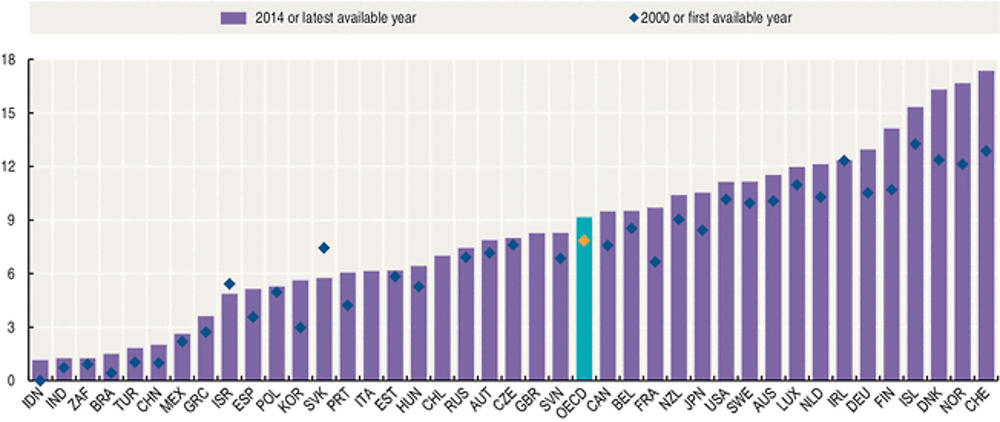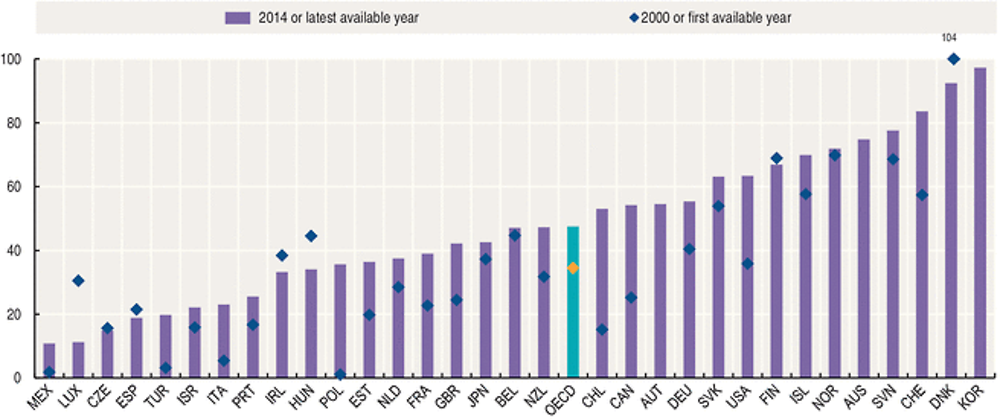Nurses
Nurses are usually the most numerous health profession, outnumbering physicians on average across OECD countries by almost three to one. However, there are concerns in many countries about shortages of nurses, and these concerns may well intensify in the future as the demand for nurses continues to increase and the ageing of the “baby-boom” generation precipitates a wave of retirements among nurses. These concerns have prompted actions in many countries to increase the training of new nurses combined with efforts to increase the retention of nurses in the profession.
Definition
The number of nurses includes all those employed in public and private settings providing services to patients (“practising”), including the self-employed. In those countries where there are different levels of nurses, the data include both “professional nurses” who have a higher level of education and perform higher level tasks and “associate professional nurses” who have a lower level of education but are nonetheless recognised and registered as nurses. Midwives and nursing aids who are not recognised as nurses are normally excluded.
Comparability
In several countries (France, Greece, Iceland, Ireland, Italy, the Netherlands, Portugal, the Slovak Republic, Turkey and the United States), the data include not only nurses providing direct care to patients, but also those working in the health sector as managers, educators, researchers, etc. Data for Chile refer to all nurses who are licensed to practice (less than one-third are professional nurses with a university degree). About half of OECD countries include midwives because they are considered as specialist nurses.
Austria reports only nurses employed in hospitals, resulting in an under-estimation.
On average across OECD countries, there were around 9 nurses per 1 000 population in 2014. The number of nurses per capita was highest in Switzerland, Norway, Denmark, Iceland and Finland, with more than 14 nurses per 1 000 population. The number of nurses per capita in OECD countries was lowest in Turkey, Mexico and Greece. The number of nurses per capita was also low compared with the OECD average in the emerging economies, such as Indonesia, India, South Africa, and Brazil where there were fewer than 1.5 nurses per 1 000 population in 2013, although numbers have been growing quite rapidly in Brazil in recent years.
The number of nurses per capita increased in almost all OECD countries over the past decade. This was the case in countries that already had a high density of nurses in 2000 such as Switzerland, Norway and Denmark, but also in Korea, Portugal and France which used to have a relatively low density of nurses. The number of nurses per capita declined between 2000 and 2014 only in Israel and the Slovak Republic.
In 2013, there were about three nurses per doctor on average across OECD countries, with about half of the countries reporting between two to four nurses per doctor. The nurse-to-doctor ratio was highest in Finland, Japan, Ireland and Denmark (with at least 4.5 nurses per doctor). It was lowest in Greece (with only about half a nurse per doctor) and in Turkey and Mexico (with only about one nurse per doctor).
There were 47 newly graduated nurses per 100 000 population on average across OECD countries in 2014. The number was highest in Korea, Denmark and Switzerland, and lowest in Mexico, Luxembourg, the Czech Republic, Spain, Turkey, Israel and Italy, with less than half the OECD average. Nurse graduation rates have traditionally been low in Mexico, Turkey, Israel and Spain, four countries which report a relatively low number of nurses per capita. In Luxembourg, nurse graduation rates are also low, but many nurses are foreign-trained.
Sources
-
OECD (2015), OECD Health Statistics (Database).
Further information
Analytical publications
-
Buchan, J. and S. Black (2011), “The Impact of Pay Increases on Nurses’ Labour Market: A Review of Evidence from Four OECD Countries”, OECD Health Working Papers, No. 57.
-
Delamaire, M. and G. Lafortune (2010), “Nurses in Advanced Roles: A Description and Evaluation of Experiences in 12 Developed Countries”, OECD Health Working Papers, No. 54.
Statistical publications
-
OECD (2015), Health at a Glance, OECD Publishing.
-
OECD (2014), Health at a Glance: Asia/Pacific, OECD Publishing.
-
OECD (2014), Health at a Glance: Europe, OECD Publishing.
Websites
-
OECD Health Statistics (supplementary material), www.oecd.org/els/health-systems/health-statistics.htm.



